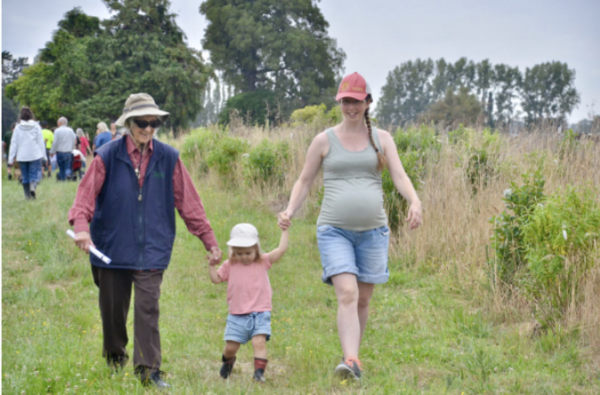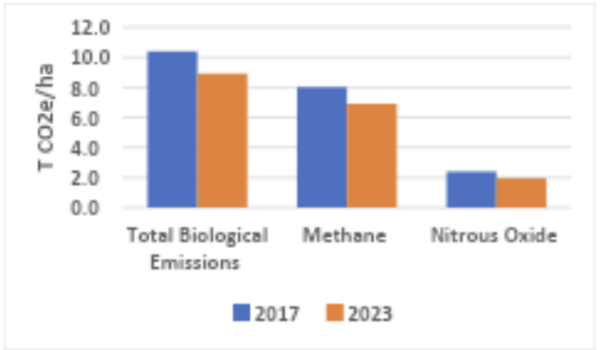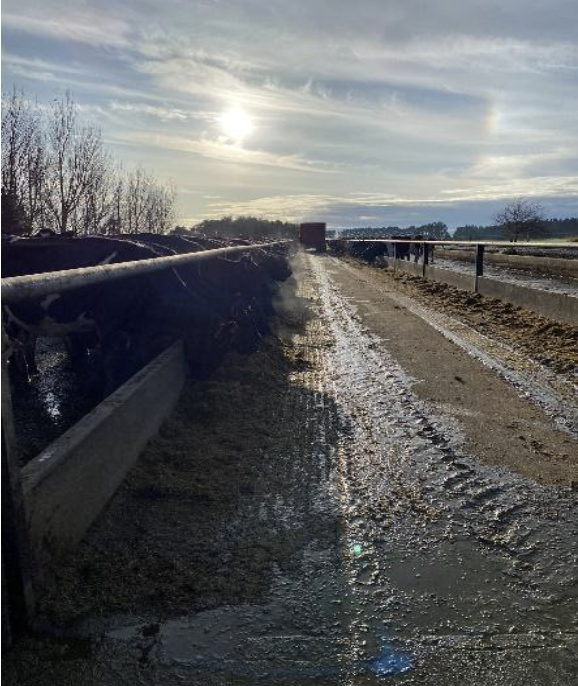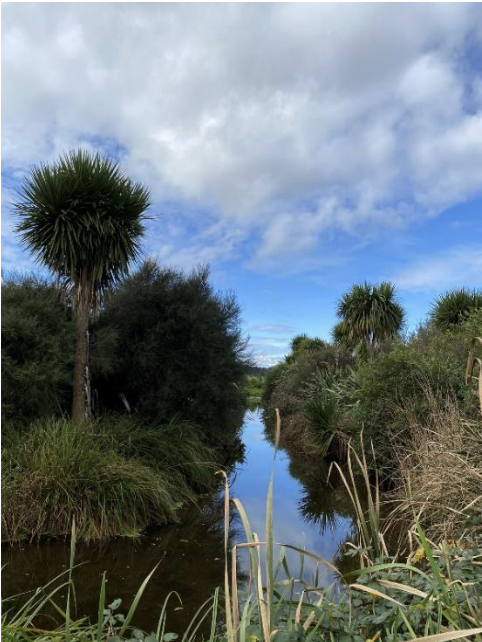Kaiwaiwai Dairies Ltd, Wairarapa
Kaiwaiwai Dairies comprises a 337-hectare milking platform, plus a 305-hectare dairy support block located in South Wairarapa, between Featherston and Martinborough.
The operation calves 500 cows in the spring, and 300 in the autumn, with the balance of the 900-cow herd being carry-overs. This farm is well known locally as a business working hard to front foot environmental sustainability.
Download this story
Download a copy of Kaiwaiwai Dairies story here [PDF, 640 KB] .
About the farm
Kaiwaiwai has been owned through an equity partnership for 19 years. It is with great pride that the six shareholders actively represent the industry as DairyNZ Dairy Environment Leaders and Climate Change Ambassadors.
Not only are the owners strong advocates and early adopters in these areas, but they also have great community and industry recognition. Kaiwaiwai is a previous Ballance Farm Environment Awards winner, among other acknowledgements.
In the past the farm operated as a System 5 farm with a high stocking rate relying heavily on imported feed to overcome a significant summer pasture deficit. Over time, the system was adjusted, and it is now a System 3 split-calving operation, allowing for a more balanced and efficient system.
There is a large range in soil type on the property, from heavy clay (12 percent) to imperfectly draining silts (57 percent), and peat (31 percent). This creates challenges with day-to-day management having to flex to the conditions while also endeavouring to look after the soils.
The water flow from the peat soils is high in nitrate due to catchment activities and the natural decomposition of organic matter.
Table 1: Cow numbers and production
| Cows |
Cows/ha |
Kg MS/Ha | kg MS/cow | |
| 2017 | 882 | 2.8 | 1,072 | 377 |
| 2023 | 910 | 2.7 | 975 | 356 |
What changes have been made?
Kaiwaiwai is on a journey of constant improvement, implementing multiple key initiatives that have a positive environmental effect.
While the total cow numbers milked have increased, so has the land area, resulting in a lower stocking rate. With less cows per hectare, emissions have reduced (Table 2).
The Kaiwaiwai constructed wetland has been reported in many publications since its creation, in 2015. This was built to collect the high nitrogen water flows from the peat soils into a specifically designed wetland that included appropriate planting. This 0.5-hectare wetland has developed into an ecological “paradise.”
Irrigation is through three pivots, covering 122 hectares in total, and has improved pasture resilience in the dry season. Careful planning and consideration have gone into developing this infrastructure.
The irrigation is designed to apply no more than 5 mm/hr through variable rate control, to avoid any unnecessary loss of water into rivers, drains, and races. This also allows controlled application to match variable soil water holding capacities and prevents over-watering.
This technology also enables remote management, controlling exactly where the water is going at all times. There is also the option to apply effluent in a controlled manner via all three pivots.
Cropping is limited on the milking platform itself, with 13 hectares grown annually. Kale has previously been used as a winter feed for winter milkers. However, moving to having less bare ground on the platform at any given time, kale has been removed from the system and the only winter crop is oats, which are drilled into existing pasture for spring calvers.
Cultivation has converted to minimum tillage on the peat land and spray and drill under irrigated land. Again, this is to minimise bare ground under irrigation.
Other environmental strategies include:
- operating an electric farm side-by-side vehicle
- recording data feeds for climate, water, soil, effluent, wetland, and silo temperatures to help keep an eye on the detail and making sure things are working correctly (it encourages proactive management for improvement)
- sloping races away from drains so run-off has an opportunity to get absorbed by pasture
- using technology to monitor water reticulation and the efficiency of water use at the cow shed
- lining the feed storage area with compact red metal, providing an impermeable layer and preventing leachate from travelling through the soil
- having a nutrient catchment zone off the feed storage area (i.e. a fenced off pond and planted with mānuka to absorb nutrients)
- control over supplement harvest and quality as all supplements are grown on the support block
- all grass silage coming in at 33 percent dry matter and maize silage at 38 percent to minimise leachate off feed
- lining the feed pad with rubber matting, enabling stand-off time to increase to five hours per day in winter to reduce impact on soils and capture nutrients into the effluent separator and capture effluent dense water for irrigation
- shifting the start of spring calving to early August to reduce early stocking pressure through late winter, and
- installing a large solar array with the purpose of supplying power to the cow shed and irrigators (successful as the farm uses 93 percent of the power it produces with this initiative, and it has generated a 14 percent return on capital).
Kaiwaiwai’s why – an eye to the future

Kaiwaiwai Dairies shareholder Aidan Bichan says family and stewardship are what drives him to go the extra mile. Among the crowds at a recent open day was Aidan’s mother, daughter and granddaughter.
“So that’s four generations of us. That’s my why,” Aidan said. “It’s about leaving the place for our children and our grandchildren and leaving it in a better state than we found it.”
GHG modelling method:
The farm was modelled in Farmax for the seasons analysed.
What have been the impacts of the changes?
Figure 1: GHG emissions (T CO2e/ha)

Table 2: Average per effective or total pastoral hectare emissions and emission intensity
| 2017 | 2023 | % Change | |
| Total biological emissions (T CO₂e/ha) | 10.4 | 8.9 |
-14% |
| Methane (T CO₂e/ha) | 8 | 6.9 | -14% |
| Methane (kg CH₄/ha) | 321 | 277 | -14% |
| Nitrous oxide (T CO₂e/ha) | 2.4 | 1.95 | -19% |
|
Emission intensity (kg CO₂e/kg MS) |
9.2 | 8.6 | -7% |
| Fertiliser N (kg N/ha) | 65 | 39 | -40% |
| kg N loss per Ha | 14 | 14 | 0% |
|
Farm profit $/Ha |
$4447 | $3658 | -18% |
- Changes to the Kaiwaiwai operation have brought about a 14 percent reduction in total greenhouse gas emissions and a 7 percent drop in emissions intensity per kilogram of milksolids since 2017.
- Methane has dropped 14 percent and nitrous oxide 19 percent.
- Nitrogen fertiliser use has been reduced by 40 percent.
- There are measurements taken at the inlet to the wetland and at the outlet back to the drain. This wetland can remove 660 kilograms of nitrogen from the water annually.
- On a standardised milk price and farm costs basis, farm profitability has reduced. That is in part a consequence of the changes, but the business has greater resilience.
What process did they go through to make the changes?
The shareholders have worked hard to grow their knowledge and skills in understanding and managing agricultural greenhouse gas emissions. They break each part of the system down to look at where the improvements or adjustments can be made and pressure test this with industry experts.
The business plan is kept under constant review. Where gains are identified in keeping with the holistic objectives, change is implemented. They believe it’s a combination of a lot of small changes that are going to keep the dairy unit sustainable and profitable.
Financial performance is monitored, and the future farm modelling work indicates the environmental footprint can be reduced as planned at no cost to profitability.

What other changes are planned?
Kaiwaiwai’s owners are constantly researching ways to reduce the farm’s environmental footprint. Engagement in local and central government advisory groups is a two-way street where they can learn while giving.
In the future, the shareholders are looking at reducing autumn calving numbers and increasing spring calving numbers.
They are also considering constructing a compost barn to provide cows time off paddocks to avoid damage to soils when they are too wet. This will further aid the focus on consistent production, reducing empty rates, keeping lameness down, and reducing their nitrogen loss to water.
The business knows further research is still needed to ensure cow housing does not erode the gains made in GHG reduction, as often using a barn can result in increased feeding levels which can increase GHG emissions.
What drives or constrains these changes?
A key constraint are the soils on the farm which have a significant bearing on how the farm operates. In winter it is prone to being extremely wet, and despite the irrigation is still influenced by summer dry conditions.
What are they doing to ensure climate resilience for Kaiwaiwai?
- Irrigation and being able to feed livestock while off the pastures is aiding resilience.
- As noted above, a compost barn will help reduce supplementary feed wastage, improve feed conversion efficiencies, enhance animal welfare especially during climatic events and capture more nutrients for recycling.
What advice do they have for other farmers?
- Seek out relevant information on the issue(s).
- Be aware of relevant mitigations by staying constantly informed.
- Participate in local community initiatives/water management groups.
- Engage with your regional council.
- Learn how farm system changes will impact on GHG emissions.
- Be brave enough to implement strategies that will bring about measurable change.
Kaiwaiwai Dairies Ltd provides a journey in farming and in business to those involved in it.
The owners have created an enjoyable business culture, are continually challenging what they do, establishing a group of likeminded people, with different skill sets, but common goals that “motivate each other in an industry that has a future but requires constant change and adaptation.”


